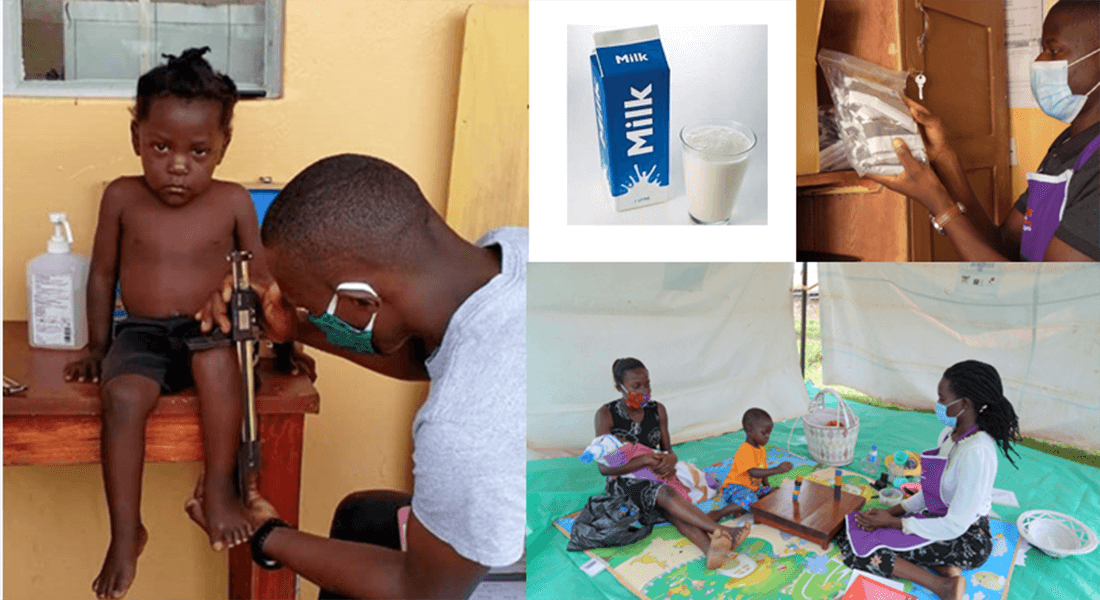PhD defence: Effect of milk protein and whey permeate in large quantity lipidbased nutrient supplement
on growth and early child development among children with stunting in Uganda

Joseph Mbabazi
PhD thesis
Background: Stunting affects 22% of children under 5 years globally, putting them at risk of adverse outcomes including delayed development. Nearly half of the children in low- and middle-income country settings (LMICs) are affected with 43% unable to attain their developmental potential. There are possible benefits for growth and early child development (ECD) by including milk in food supplements for undernourished children. However, the effect
of individual milk ingredients is still unclear.
Objective: We assessed the effect of milk protein (MP) vs soy protein, and whey permeate (WP) vs maltodextrin, in large quantity lipid-based nutrient supplement (LNS), and LNS itself vs no supplementation on growth and ECD among 12 – 59-month-old children with stunting. The baseline correlates, and predictors of change in ECD were also examined.
Methods: This study was nested within the MAGNUS trial (ISRCTN1309319) a randomized, double-blind, 2x2 factorial community-based trial in Uganda. Children were randomized to one of four formulations of LNS (~535 kcal/d), with or without MP (n=299 vs n=301), with or without WP (n=301 vs n=299), for 12 weeks or to no supplementation (n=150). Growth was measured by changes in length/height and weight plus changes in body composition.
Development was assessed using the Malawi Developmental Assessment Tool (MDAT). Age adjusted MDAT z-scores were generated internally for the study sample across four domains of gross and fine motor, language and social skills, plus a summative total score. The effects of interventions were analysed based on intention-to-treat using linear mixed-effects models while linear regression was used to assess any linear relationship unless otherwise.
Results: Between February to September 2020, 750 children were enrolled with a median [interquartile range] age of 30 [23; 41] months. Their mean (±standard deviation) height-forage z-score (HAZ) was -3.02 ±0.74, there were 13% (n=95) currently breastfed children, slightly over half (n=415) resided in rural settings, and 21% (n=157) were from female-headed households, and 47% (n=338) of the mothers had no schooling. Only 4% (n=33) of the households were food secure with a quarter (n=196) eating a diverse diet. There were 98% (n=736) of children, evenly distributed among groups, who completed the 12-week follow-up. Eleven serious adverse events occurred to 1.3% (n=10) of the children which mainly included hospitalization due to illness (malaria and anaemia). All of these were deemed unrelated to the interventions.
Among the unsupplemented children, there was a decline of 0.06 (95% CI: 0.02; 0.10) HAZ with an increase of 0.29 (95% CI: 0.20; 0.39) kg/m2 fat mass index (FMI), and decline of 0.06 (95% CI: -0.002; 0.12) kg/m2 fat-free mass index (FFMI). There were no interactions between effects of MP and WP. Neither MP nor WP had any effect on growth or ECD, but, LNS irrespective of milk ingredients vs no LNS improved growth, including head circumference. Overall, LNS itself led to 0.56 (95% CI: 0.42; 0.70) cm greater height increment, corresponding to 0.17 (95% CI: 0.13; 0.21) greater HAZ increment, and 0.21 (95% CI: 0.14; 0.28) kg greater weight gain, of which 76.5% (95% CI: 61.9; 91.1) was fat-free mass (FFM). In addition, LNS itself resulted in 0.07 (95% CI: 0.004; 0.14) cm greater increase of head circumference.
The degree of stunting [HAZ (0.24, 95% CI: 0.14; 0.33)], head circumference (0.07, 95% CI:0.02; 0.12), and stimulation were positively associated with total MDAT z-score. On the contrary, current breastfeeding (-0.41, 95% CI: -0.65; -0.17), and having a single income earner (-0.22, 95% CI: -0.37; -0.06) were negatively associated with total MDAT z-score. Furthermore, stunting severity (moderate vs severe), higher fat-free mass, negative malaria test and no inflammation (serum α-1-acid glycoprotein <1 g/l) at baseline, predicted greater increase in ECD. On the contrary, older age and fat mass gain predicted lesser increase in ECD scores over time among children with stunting.
Conclusion: This study found that milk ingredients in LNS had no effects on growth or ECD among already stunted children. However, LNS in itself vs no supplementation resulted in improved linear catch-up growth, accretion of fat-free but not fat mass, and a larger increase of head circumference. In contrast, unsupplemented children continued on a stunting trajectory, and mainly gained fat at the expense of FFM. Smaller and anaemic children tended to be breastfed longer, perhaps explaining the association between current breastfeeding and low ECD scores by reverse causality. In view of the consequences without action, nutrition supplementation programs to treat children with stunting should be considered. The correlates and predictors of ECD identified in this study may inform future initiatives to support children with stunting to attain their developmental potential. There is a need to emphasize timeliness of interventions, focusing on younger children, promoting continued breastfeeding, and fat-free, rather than fat mass accretion. This should include ensuring an infection-free and stimulative home environment to promote improvement in ECD among children with stunting in LMICs.
2024, 172 pages.
Time
28 May 2024, 08:00
Place
MakCHS Conference Room, Makerere University, Uganda.
Join Zoom Meeting
https://zoom.us/j/92964651207?pwd=TTFGc2tCcmVKdWNnS0g4T1ZwcVV1UT09
Meeting ID: 929 6465 1207
Passcode: 643748
Opponents
Professor Jay Berkley, Oxford University, London – United Kingdom, Welcome Trust KEMRI, Kenya.
Professor Annettee Olivia Nakimuli, Dean, School of Medicine, MakCHS, Uganda (Chair).
Supervisors
Associate Professor Ezekiel Mupere, Department of Paediatrics & Child Health, Makerere University College of Health Sciences, Uganda.
Associate Professor Nicolette Nabukeera-Barungi, Department of Paediatrics & Child Health, Makerere University College of Health Sciences.
Professor Henrik Friis, Department of Nutrition, Exercise and Sports, Nutrition and Health Section, University of Copenhagen, Denmark.
Associate Professor Mette Frahm Olsen, Department of Infectious Diseases, Righospitalet and Department of Nutrition, Exercise and Sports, Nutrition and Health Section, University of Copenhagen, Denmark.
